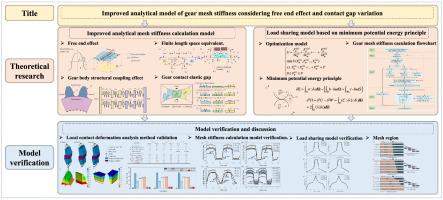考虑自由端效应和接触间隙变化的齿轮啮合刚度改进分析模型
IF 4.4
2区 工程技术
Q1 ENGINEERING, MULTIDISCIPLINARY
引用次数: 0
摘要
在齿轮系统中,啮合刚度被认为是一个重要的内部激励,对齿轮动力学有重要影响。现有的啮合刚度计算解析模型在确定接触刚度时没有考虑自由端应力集中,在建立单齿和双齿啮合区间时忽略了接触间隙的变化,导致计算精度不高。本文提出了一种考虑自由端效应和接触间隙变化的分析方法,以实现高效、精确的计算。该方法基于赫兹接触理论、半空间理论和最小势能原理,采用弹性四分之一空间快速校正方法确定校正系数。赫兹接触理论和半空间理论可以精确计算齿宽中点处的局部接触变形。弹性四分之一空间快速修正方法有效地考虑了有限长度空间中的自由末端效应,实现了局部接触刚度的精确计算。在此基础上,考虑齿轮体结构耦合效应和弹性接触间隙变化,建立了啮合刚度计算模型。通过有限元基准和现有常用方法验证了所提方法的精度和效率。本文章由计算机程序翻译,如有差异,请以英文原文为准。

Improved analytical model of gear mesh stiffness considering free end effect and contact gap variation
In gear systems, mesh stiffness is regarded as a significant internal excitation with critical influences on the gear dynamics. The existing analytical model for mesh stiffness calculation determines contact stiffness without accounting for stress concentration at the free end, and it neglects variations in the contacting gap when establishing the meshing interval for single and double teeth, resulting in calculation inaccuracies. This paper proposes an analytical method(AM) to achieve highly efficient and precise calculations by considering free end effect and contact gap variation. The method developed correction coefficients using the elastic quarter-space quick correction method, based on Hertz contact theory, half-space theory, and minimum potential energy principle. Hertz contact theory and half-space theory can precisely compute the local contact deformation at the midpoint of tooth width. The elastic quarter-space fast correction method effectively accounts for the free end effect in finite-length space, enabling accurate calculation of local contact stiffness. A mesh stiffness calculation model is built based on the method recommended, considering gear body structure coupling effect and elastic contact gap variation. The precision and efficiency of the proposed method(PM) are verified by finite element method (FEM) benchmarks and existing common methods.
求助全文
通过发布文献求助,成功后即可免费获取论文全文。
去求助
来源期刊

Applied Mathematical Modelling
数学-工程:综合
CiteScore
9.80
自引率
8.00%
发文量
508
审稿时长
43 days
期刊介绍:
Applied Mathematical Modelling focuses on research related to the mathematical modelling of engineering and environmental processes, manufacturing, and industrial systems. A significant emerging area of research activity involves multiphysics processes, and contributions in this area are particularly encouraged.
This influential publication covers a wide spectrum of subjects including heat transfer, fluid mechanics, CFD, and transport phenomena; solid mechanics and mechanics of metals; electromagnets and MHD; reliability modelling and system optimization; finite volume, finite element, and boundary element procedures; modelling of inventory, industrial, manufacturing and logistics systems for viable decision making; civil engineering systems and structures; mineral and energy resources; relevant software engineering issues associated with CAD and CAE; and materials and metallurgical engineering.
Applied Mathematical Modelling is primarily interested in papers developing increased insights into real-world problems through novel mathematical modelling, novel applications or a combination of these. Papers employing existing numerical techniques must demonstrate sufficient novelty in the solution of practical problems. Papers on fuzzy logic in decision-making or purely financial mathematics are normally not considered. Research on fractional differential equations, bifurcation, and numerical methods needs to include practical examples. Population dynamics must solve realistic scenarios. Papers in the area of logistics and business modelling should demonstrate meaningful managerial insight. Submissions with no real-world application will not be considered.
 求助内容:
求助内容: 应助结果提醒方式:
应助结果提醒方式:


